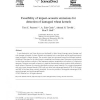Free Online Productivity Tools
i2Speak
i2Symbol
i2OCR
iTex2Img
iWeb2Print
iWeb2Shot
i2Type
iPdf2Split
iPdf2Merge
i2Bopomofo
i2Arabic
i2Style
i2Image
i2PDF
iLatex2Rtf
Sci2ools
DSP
2007
2007
Feasibility of impact-acoustic emissions for detection of damaged wheat kernels
A non-destructive, real time device was developed to detect insect damage, sprout damage, and scab damage in kernels of wheat. Kernels are impacted onto a steel plate and the resulting acoustic signal analyzed to detect damage. The acoustic signal was processed using four different methods: modeling of the signal in the time-domain, computing time-domain signal variances and maximums in short-time windows, analysis of the frequency spectrum magnitudes, and analysis of a derivative spectrum. Features were used as inputs to a stepwise discriminant analysis routine, which selected a small subset of features for accurate classification using a neural network. For a network presented with only insect damaged kernels (IDK) with exit holes and undamaged kernels, 87% of the former and 98% of the latter were correctly classified. It was also possible to distinguish undamaged, IDK, sprout-damaged, and scab-damaged kernels. © 2005 Elsevier Inc. All rights reserved.
| Added | 13 Dec 2010 |
| Updated | 13 Dec 2010 |
| Type | Journal |
| Year | 2007 |
| Where | DSP |
| Authors | Tom C. Pearson, A. Enis Çetin, Ahmed H. Tewfik, Ron P. Haff |
Comments (0)

